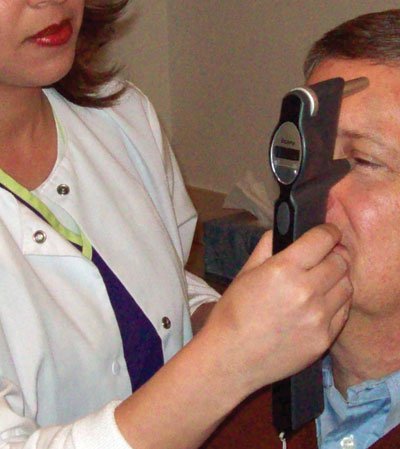Clinicians report portable rebound tonometer to be accurate, user-friendly
A portable rebound tonometer offers safe and accurate IOP measurement without anesthetic drops, particularly for children, the disabled and the elderly.
The iCare tonometer is comparable to Goldmann applanation tonometry, according to two optometrists who spoke to Primary Care Optometry News. Data from selected studies also attested to the iCare’s accuracy and suitability to some patients.
Study data highlighted one caveat: central corneal thickness (CCT) can significantly influence IOP readings taken with the iCare. Still, corrected IOP readings are compatible with Goldmann applanation values.
The iCare tonometer, manufactured by Tiolat Oy of Helsinki, Finland, and distributed by the Diagnostic Instrument Group (DIG, Tampa, Fla.), was approved by the U.S. Food and Drug Administration in May 2007.
 The iCare tonometer can be carried from exam room to exam room. Image: Mothershead F |
“Our experience with this has been nothing but positive,” Fred Mothershed, OD, told PCON in an interview. “We’ve used it about a year.”
The iCare tonometer is particularly well-suited to children and patients with special needs, PCON Editorial Board member John A. McCall Jr., OD, said in an interview.
“The standard of care is that you must take a pressure on everybody that walks into your office, period,” he said. “I think it works extremely well for nursing homes and wheelchair patients. It’s a must for something like that.”
One other portable tonometer (Tono-Pen, Reichert) is also FDA-approved.
How it works
The iCare tonometer has a tiny rebounding probe that makes brief contact with the corneal surface and measures IOP in a few microseconds. The brief contact eliminates the need for topical anesthesia and the risk of microbiological contamination with the single-use disposable probe, according to a DIG news release.
Users describe accuracy, utility
Dr. McCall said he found the iCare comparable to Goldmann applanation and more accurate than the Tono-Pen in his practice. Averaging multiple IOP readings produce the best result.
“You do five readings and it gives you an average of those five,” Dr. McCall said. “I did a miniature study in my practice, and it more closely resembled the accuracy of the Goldmann than did my Tono-Pen.”
The iCare tonometer is slightly more accurate measuring pressure in the normal range than in the high or low ranges, similar to the traditional air puff method, Dr. Mothershed said.
“If you get a really high pressure – 28 mm Hg to 32 mm Hg – then sometimes it tends to read a little higher than it actually is,” he said. “It’s kind of the same way on the low end. If you’re around 10 mm Hg or 11 mm Hg, then you may get a little lower reading by about a point or two.”
However, the slight discrepancies are not problematic, he said.
Dr. McCall pointed to the iCare’s portability and ease of use.
“You can take it from room to room,” he said. “You can use it in a diagnostic area … You can go out in the waiting room and do it. That’s how portable it is.”
Dr. Mothershed commented that it is easy to train your staff to use the iCare tonometer.
Data show clinical reliability
A study published in the Journal of Glaucoma in 2006 showed corrected IOP readings taken with the iCare agreeing with those taken with Goldmann applanation. However, the data showed central corneal thickness (CCT) influencing iCare readings. For example, the deviations of iCare readings from GAT values showed a statistically significant correlation to CCT (P < .01).
The study authors recommended considering pachymetry when assessing IOP measurements taken with the iCare tonometer.
A 2007 Journal of Glaucoma study showed IOP measurement with a rebound tonometer to be highly appropriate for children ages 7 years to 15 years. Data showed that 98.6% of subjects felt no pain or discomfort when tested with the iCare tonometer.
A study published in the American Journal of Ophthalmology in 2006 showed strong agreement between the iCare tonometer, Goldmann applanation, Tono-Pen and a noncontact tonometer. Mean differences between the iCare, Goldmann applanation and noncontact device were 1.40 mm Hg, 0 mm Hg and 2.22 mm Hg, respectively.
The iCare tonometer significantly overestimated IOP compared with Goldmann and Tono-Pen tonometries as CCT increased, the authors said.
For more information:
- John A. McCall, Jr., OD, is a Primary Care Optometry News Editorial Board member, a private practitioner and senior vice president of vendor relations for Vision Source. He can be reached at 711 East Goliad Ave., Crockett, TX 75835; (936) 544-3763; fax: (936) 544-7894; e-mail: jmccall@visionsource.com. Fred Mothershed, OD, can be reached at Wesson and Mothershed Eye Center, 3353 North Gloster Ave., Tupelo, MS 38804; (662) 844-3555; e-mail: drmothershed@wandmeyecenter.com. Drs. McCall and Mothershed have no direct financial interest in the products mentioned in this article, nor are they paid consultants for any companies mentioned.
References:
- Brusini P. Salvetat ML, Zeppieri M, Tosconi C, Parisi L. Comparison of Icare tononometer with Goldmann Applanation Tonometer in glaucoma patients. J Glaucoma. 2006;15(3):213-217.
- Nakamura M, Darhad U, Tatsumi Y, Fujioka M, et al. Agreement of rebound tonometer in measuring intraocular pressure with three types of applanation tonometers. Am J Ophthalmol. 2006;142(2):332-334.
- Sahin A, Basmak H, Niyaz L, Yildrim N. Reproducibility and tolerability of the Icare rebound tonometer in school children. J Glaucoma. 2007;16(2):185-188.
- The iCare tonometer is available from Diagnostic Instrument Group, 8404 Sunstate St., Tamp, FL 33634; (877) 344-8733 or (813) 926-3447; Web site: www.edigonline.com
